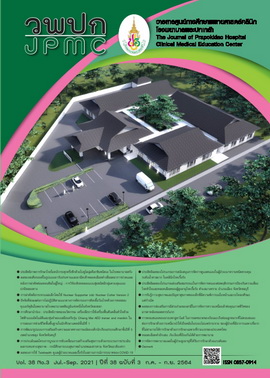Nursing Management for older patients who received Negative Pressure Wound Therapy
Main Article Content
Abstract
Negative Pressure Wound Therapy (NPWT), a wound treatment, applied the sub - atmospheric under the closed system which is widely used in the present day. This therapy is especially utilized in elderly patients suffering from chronic wounds such as pressure sores and diabetic ulcers. To enhance wound healing process and reduce wound healing time, the NPWT increases the adsorption of secretion of wounds, decreases the swelling of tissues and raises blood flow to the wound surface. The elders having age - related deterioration cause the deceased skin integrity, lack of skin elasticity and delayed the process of wound healing. Caring for wounds in the elderly patients must be specific to prevent possible complications. Nurses play a significant role in taking care of elderly patients with negative pressure wound therapy. Therefore, nurses should have knowledge and understanding of elderly body changes including the management of wound healing for preventing and being aware of complication in order to achieve the treatment goal.
Article Details
References
Bonifant H, Holloway S. A review of the effects of ageing on skin integrity and wound healing. Br J Community Nurs 2019; 24(Sup3): S28-S33.
Shah P, Aung TH, Ferguson R, Ortega G, Shah J. Ethical consideration in wound treatment of the elderly patient. J Am Coll Clin Wound Spec 2016; 6:46-52.
Gould L, Abadir P, Brem H, Carter M, Conner-Kerr T, Davidson J, et al. Chronic wound repair and healing in older adults: current status and future research. Wound Repair Regen 2015; 23:1-13.
Strazzieri-Pulido KC, Peres GR, Campanili TC, de Gouveia Santos VL. Incidence of skin tears and risk factors: a systematic literature review. J Wound Ostomy Continence Nurs 2017; 44:29-33.
Gorecki C, Brown JM, Nelson EA, Briggs M, Schoonhoven L, Dealey C, et al. Impact of pressure ulcers on quality of life in older patients: a systematic review. J Am Geriatr Soc 2009; 57:1175-83.
Nazarko L. Negative pressure wound therapy for older residents. Nursing and Residential Care 2009; 11:69-72.
Kim PJ, Attinger CE, Constantine T, Crist BD, Faust E, Hirche CR, et al. Negative pressure wound therapy with instillation: international consensus guidelines update. Int Wound J 2020; 17:174-86.
Bazalinski D, Wiech P, Baranska B, Binkowska-Bury M. Use of negative pressure wound therapy in a chronic leg wound with coexisting rheumatoid arthritis: a case study. J Int Med Res 2018; 46: 2495-99.
Wound Care Centers. Negative pressure wound therapy [Internet]. 2016 [cited 2020 Dec 2]. Available from: https://www.woundcarecenters.org/article/wound-therapies/negative-pressure-wound-therapy
Bonsall L. The essentials of negative pressure wound therapy (NPWT): part 2 [Internet]. [cited 2020 Dec 1]. Available from: https://www.nursingcenter.com/ncblog/april-2016/the-essentials-of-negative-pressure-wound-ther-(1)
Kovač Blaž M, Švab I. A multidisciplinary approach to treating obesity in a community health centre. Zdr Varst 2015; 54:252-8.
Rock R. Guidelines for safe negative-pressure wound therapy: rule of thumb: assess twice, dress once. Wound Care Advisor 2014;3(2) 29 – 33
Manduz Ş, Ada F, Ada Y. The level of awareness and the attitude of patients recommended for use of compression stockings in Turkish society, and investigation of the factors affecting their use. Patient Prefer Adherence 2018; 12:399-407.
Burgess E, Hassmén P, Pumpa KL. Determinants of adherence to lifestyle intervention in adults with obesity: a systematic review. Clin Obes 2017; 7:123-35.
Van Hecke A, Grypdonck M, Beele H, Vanderwee K, Defloor T. Adherence to leg ulcer lifestyle advice: qualitative and quantitative outcomes associated with a nurse-led intervention. J Clin Nurs 2011; 20:429-43.
Tinker LF, Rosal MC, Young AF, Perri MG, Patterson RE, Van Horn L, et al. Predictors of dietary change and maintenance in the Women's Health Initiative Dietary Modification Trial. J Am Diet Assoc 2007; 107:1155-66.

